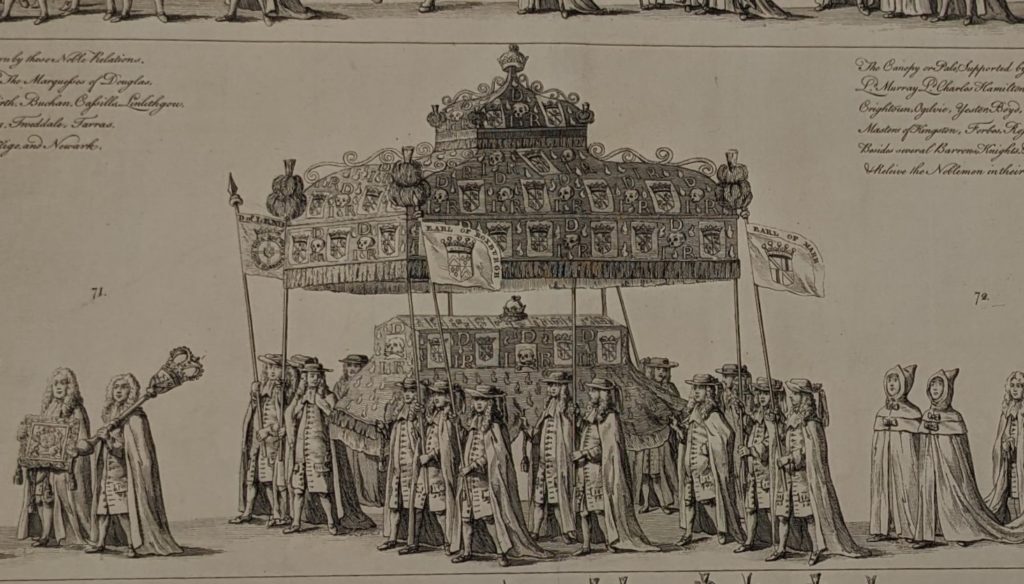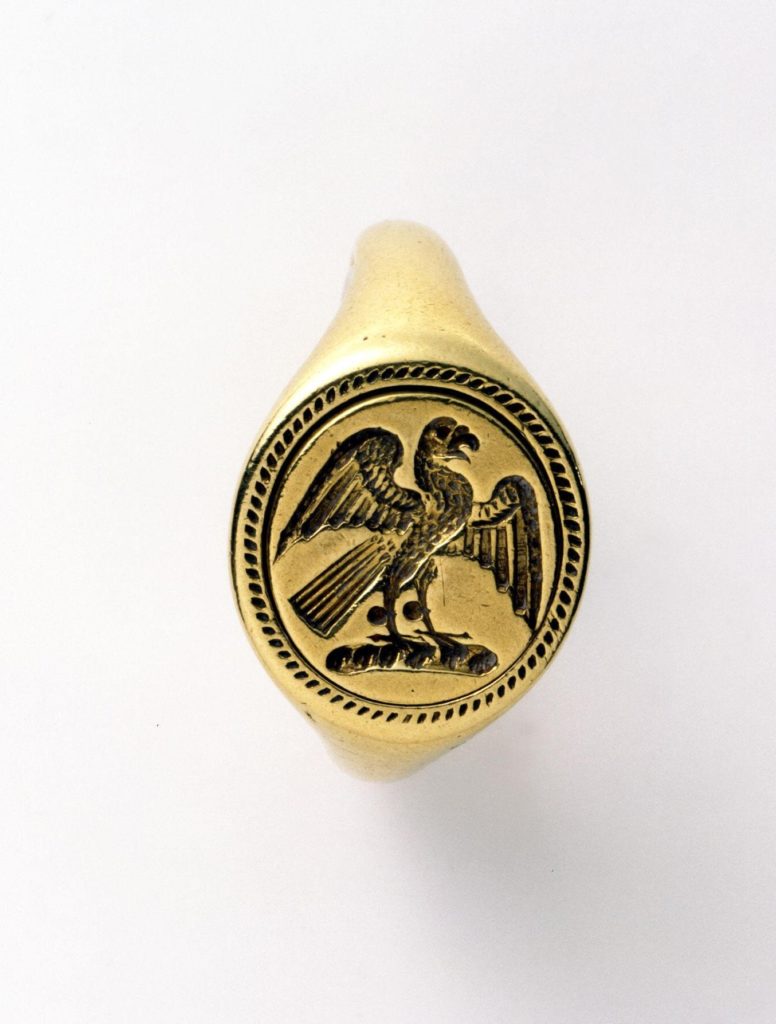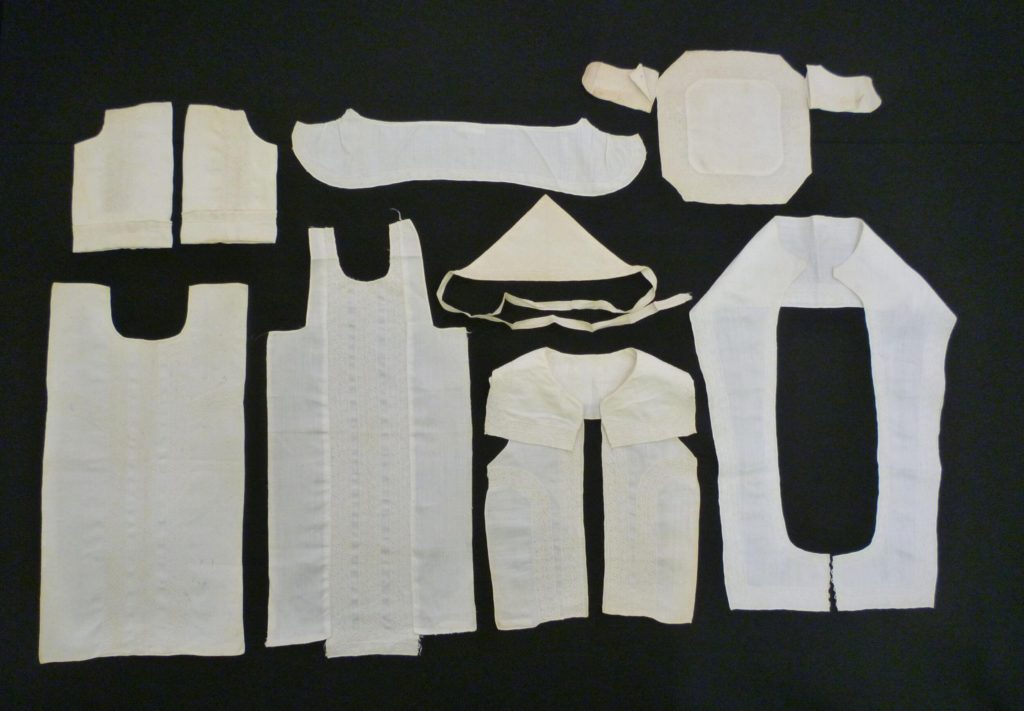Posted by e.m.vine@exeter.ac.uk
29 October 2024The end of October and the beginning of November marks ‘Allhallowtide’ – the time of the year when Western Christians, including in early modern England, have traditionally turned their thoughts to the dead with the marking of All Hallows’ Eve, All Saints’ Day, and All Souls’ Day. While Protestantism rejected purgatory and prayers for the dead, post-Reformation England saw the localised continuance of Allhallowtide traditions such as the ringing of bells to comfort the dead, the baking of ‘Soul Mass cakes’, and the reciting of phrases such as ‘God have your soul, Bones and all’.[1] This October ‘Will of the Month’ post features a Halloween-appropriate bequest – a ‘deaths head Ring’ – in other words, a ring with some sort of skull on it. This ring was mentioned in the will of Alice Walter, a widow of the parish of St Sepulchre in the City of London, who died in September 1665.[2] It may have looked similar to the seventeenth-century example below, which is held at the British Museum – a gold mourning ring with a white enamelled skull.

The very act of making a will is of course predicated on looking ahead and preparing for death, but the contents of a will, and the presence of certain objects, can also hint at a testator’s broader thoughts about mortality. In our previous ‘Will of the Month’ post, we discussed the Exeter Alderman Thomas Hunte, who pre-emptively had his own tombstone made, and kept it in his house. Alice Walter’s will opened with a formulaic comment on the inevitability of death – she acknowledged ‘this short and Transitory life’ and had decided to write down her intentions ‘considering the certainty of death and the uncertainty of the tyme thereof’.
‘Memento mori’ and mourning rings
Rings with iconography such as skulls, bones, and coffins were a form of ‘memento mori’ jewellery that was popular in the seventeenth century: items which were owned and worn to focus one’s mind upon preparation for death in everyday life. Walter died in London at the height of the Great Plague of 1665 – so it is possible that the circumstances focused her mind somewhat on preparing for her latter end. Yet the ‘deaths head Ring’ appears to have been a longer-held possession. Memento mori rings were not necessarily the same as mourning rings, which also appear frequently in wills. Mourning rings were commemorative: they were often purchased specially following an individual’s death – indeed testators often set aside money for this purpose. At gentry funerals, they were sometimes dispersed as tokens to attendees, and mourners would keep them as a means of remembering the deceased.[3] Often testators might disperse or leave money for several mourning rings, and specify how much each should cost: some beneficiaries might be worthy of a ring valued at 20 shillings, others only 10 shillings.

Three Gold (?) Rings
Walter did not identify the ‘deaths head Ring’ as a mourning ring as such. She left it to her daughter, Mary Long, and in the same clause she left her wedding ring to her other daughter, Anne Worsley. Later in the will, Walter left to her son Clement ‘my seale Ring’. A seal ring would be engraved with a personal mark or family crest, and would be pressed into sealing wax to leave an official stamp on a document. As Walter was a widow, it is likely that this was her husband’s seal ring, passed on to the eldest son. All three of Walter’s children received a ring owned, used, or worn in her lifetime, rings which had practical functions and personal meaning as well as financial value. Walter’s will took pains to record the identifying features or purpose of each ring, to ensure that the correct item of jewellery was set aside amongst her personal effects, and passed to the correct beneficiary. Walter gives us no further information about the materials the rings were made of or her reasons for bequeathing them as she did, so we can’t know for certain why one daughter received the wedding ring, and one the skull.

‘Part and share alike’
This careful division of possessions between her three children is also apparent in Walter’s other bequests. Equally, alongside the striking reference to an object associated with death, there is also life. She left ‘my Childbedd sheete’ along with ‘my best Curtaines and vallens with Stooles and Cushions of the same… and Two paire of holland Pillowbeers’ for ‘the joynt use and benefit of every one of my Children as they shall have occasion to make use of them’. The childbed sheet, like other childbed linen, could be a practical as well as a personally significant bequest, as similarly described linen would often be shared and exchanged between female friends and relatives at times of need. Acknowledging that the linen, alongside other soft furnishings, could be used by any of her children who had ‘occasion to make use of them’, Walter’s will looked ahead to providing things of practical use to her children at their different stages of life.

Walter also left ‘unto my said Two daughters All my wearing Apparell both Lynnen and woollen to be devided equally between them part and share alike And alsoe foure Pewter dishes a peece and they to take their Choyce’. This clause hints at a degree of trust in her daughters, that they were permitted to choose and would be able to amicably divide up these items between them. But there was perhaps not the same degree of trust bestowed upon her son and executor, Clement Walter. She left each of her daughters a bed, one of which was the ‘ffeather=bedd in the upper Chamber of my dwelling house called Clems chamber’. As well as this room being still known as ‘Clem’s chamber’, it appears that Clement would also inherit the lease of her main dwelling house in ‘Katherine wheeleyard’. Walter seems to have been concerned that Clement would not give up the large items of furniture, and accordingly left the following contingency: ‘But in case my Executor shall not be willing to part with the before mencioned Goods […] in Lieu thereof I doe give unto either of my said Two daughters the summe of Tenn pounds a peece’.
Tokens of love?
Her son and executor Clement, as well as being entrusted with the house and the residue of his mother’s estate, was also specifically left a ‘Beere Bowle Salt and Two Spoones of silver’. Alongside her executor, Walter also appointed two overseers of her will, William Holloway and John Fowler, and bequeathed ‘for there care and paines to be taken therein I give unto either of them the Summe of Tenn shillings for a token of love’. The bequests in Alice Walter’s will span large shifts in scale: her dwelling house, her featherbed, two spoons, three small rings. The phrase ‘token of love’ summarises some of the careful decisions that Walter had made: dividing up her clothes between her daughters, recompensing the overseers’ careful work, pre-empting and counteracting her son’s potential reluctance to part with her household furniture. Indeed the three identified rings – the seal ring, the wedding ring, and even the ‘deaths head Ring’, carefully set aside and assigned to each of her three children, were all in their own way tokens of love.
PROB 11/317/428, Will of Alice Walter, Widow of Saint Sepulchre, City of London, 04 September 1665
Alicia Walter
In the Name of God Amen
the one and Twentieth day of August Anno Domini one Thousand Six
hundred Sixty ffive and in the Seaventeenth yeare of the Reigne of
our Soveraigne Lord Charles the Second by the grace of God King of
England Scotland ffrance and Ireland defender of the ffaith xc I Alice
Walter of the parish of St Sepulchers London widdow being at this
present in good health sound and perfect mind and memory Praysed
be God but considering the certainty of death and the uncertainty of
the tyme thereof doe (for the avoiding of Suits and controversies which
may otherwayes arise after my decease) make and ordaine this my
present last will and Testament in manner and forme following
(That is to say) ffirst and above all other things I committ and Commend
my soule into the hands of Almighty God my maker and Creator and
of Jesus Christ my onely Saviour by whose meritts and Satisfaction
I stedfastly beleive to have the full and free pardon of all my sinnes
and eternall life after this short and Transitory life is ended My body
I committ to the earth whereof it was made to be decently buried att the
discretion of my Executor hereafter named And for such Temporall
Estate as God in his mercy hathe beene pleased to bestow upon me I
give dispose and bequeath the same in manner following (That is to say)
ffirst I give and bequeath unto my daughter Mary Long one ffeather=
bedd in the upper Chamber of my dwelling house called Clems
Chamber and all things thereunto belonging Item I give unto my
daughter Anne Worsley one featherbedd with all that belongs thereunto
But in case my Executor shall not be willing to part with the
before mencioned Goods given unto my said Two daughters Then my
will and mind is and in Lieu thereof I doe give unto either of my
said Two daughters the summe of Tenn pounds a peece Item I
further give and bequeath unto my said Two daughters All my
wearing Apparell both Lynnen and woollen to be devided equally
betweene them part and share alike And alsoe ffoure Pewter dishes
a peece and they to take their Choyce Item I give unto my said
daughter Mary Long my deaths head Ring And to my daughter
Anne Worsley my Wedding Ring Item I give unto sonne Cle=
ment Walter, my Beere Bowle Salt and Two Spoones of silver and
my Seale Ring And all the rest of my Plate I give equally betweene
my said Two daughters Item I give unto my daughter Anne
Worsley one messuage or Tenement contayning ffoure Roomes now in
the
[new page]
The occupation of ffrancis hinde Scytuate in Katherine Wheele yard
in the said Parish of St Sepulchers London for and dureing all the terme
of yeares which att the tyme of my decease shalbe to come in the Lease
whereby I hold the same messuage or Tenement (amongst other things)
And I further give unto my said daughter Ann Worsley One Annuity of
fforty shillings of Lawfull money of England to be issueing and payable
out of the Rents and profitts of the said Lease dureing all the terme therein
to come att my decease The same to be paid unto her Quarterly the first
payment to be made upon such of the ffoure standing Quarters in the
yeare as shall next happen after my decease But in case my said daughter
shall dye or depart this life before the expiracion of the terme of yeares
mecioned in the said Lease Then I give the said messuage or Tenement
before mencioned to be given to my said daughter And also the said
Annuity of fforty shillings unto my Grandsonne John Worsley dureing
the reamainder of the terme of yeares granted in the said Lease (if hee
shall soe long live) (Item my will and mind is That my best Curtaines
and vallens with Stooles and Cushions of the same my Childbedd sheete
and Two paire of holland Pillowbeers shalbe for the joynt use and benefitt
of every one of my Children as they shall have occasion to make use of
them The same to remaine in the Custody of my said daughter Mary Long
dureing her life And after her decease in the Custody of my daughter
Anne Worsley dureing her Life and after their deceases Then the same to remaine in
the Custody of my said sonne Clement Walter And I doe give the Same
last mencioned goods to the longer liver of my said Children and of their
Childrens Children Item I give and bequeath unto my Said daughter
Anne Worsley Three paire of sheetes and a paire of Lockeram Pillowbeeres
Item I give unto my Two Grandchildren Jonas Long and Mary Long ffive
pounds a peece to be paid unto them and the survivor of them att their respect=
tive ages of Tenn yeares But if both my said Grandchildren shall dye or
depart this life before they or one of them shall attain the age of Tenn
yeares Then I give the saide Legacies of ffive pounds and of ffive pounds unto
my said daughter Mary Long (if shee be then liveing) Item I give unto my
Grandsonne John Worsley the summe of ffive pounds To be paid unto him
att his age of Tenn yeares but in Case my said Grandsonn shall dye or
depart this life before hee attaine the said Age of Tenn yeares Then I give
the said summe of ffive pounds unto my said Daughter Anne Worsley
Item I give unto my brother Edward Daywood the summe of ffive pounds
to be paid unto him by Tenn shillings a Quarter the ffirst payment to be
made within one yeare after my decease And soe Consequently Tenn Shillings
every Quarter of a yeare until the summe of ffive poundes be paid (if my
brother soe long live) Item I give and bequeath the lease of my said
houses in Katherine wheeleyard (Except the said Tenement and Annuity
before given unto my said daughters Anne Worsley unto my sonne Cle=
ment Walter dureing all the terme of yeares therein granted (if he soe
long live) But if my said sonne Clement shall dye or depart this life before
the Expiracion of the said terme having noe yssue of his body then livring
Then I give the said Lease (Except before Excepted) unto and amongst my
aforesaid Two daughters and their Children Equally betweene them Item
all the rest of my Estate (my due debts being ffirst paid and funeral ex=
pences and Legacies discharged) I wholly give and bequeath the same unto
my said sonne Clement Walter whom I doe make full and sole Executor
of this my will And I doe desire and entreate my Loveing ffreinds William
ffowler
[next page]
Fowler and John Holloway to be overseers of this my will And to be
assisting to my Executor by their best advice and Counsell And for their
care and paines to be taken therein I give unto either of them the Summe of
Tenn shillings for a token of love And I doe hereby revoke and make
void All former wills gifts and bequests whatsoever And my will and mind
is That this onely shall remaine and be for and as my last will and
Testament In Witnes whereof I the said Testatrix have to every sheet
of this my will contayning in number Three sheets of written paper sett my
hand and seale And ffixed my seale to a Labell annexed on the Topp thereof
The day and yeare ffirst above written Alice Walter her marked / signed
sealed and declared by the said Testatrix for and as her last will in the
presence of Joi Bryan scr Ric: Bull his servt. /
[1] Ronald Hutton, ‘Saints and Souls’ in The Stations of the Sun: A History of the Ritual Year in Britain, (Oxford University Press, 1996), p.374
[2] PROB 11/317/428, Will of Alice Walter, Widow of Saint Sepulchre, City of London, 04 September 1665.
[3] See David Cressy, Birth, Marriage, and Death: Ritual, Religion and the Life-Cycle in Tudor and Stuart England, (Oxford University Press, 1997) p.453.